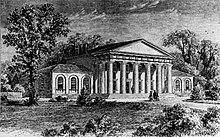Caroline Branham
In the 1820s, Jared Sparks interviewed her for his biography of Washington, which she did in exchange for the freedom of her grandson, a toddler at the time, Robert H. Robinson.[2] In the early morning, she lit fireplaces in the mansion to warm the rooms, including the occupied bed chambers, before the family and any guests awoke.[6] Her work included: washing clothes and linens, dusting furniture, cleaning floors, and other household duties.[2] A house bell system, built in the 1780s, summoned domestic workers to the piazza, dining rooms, or bedrooms.[2] I beg you will make Caroline put all the things of every kind out to air and Brush and Clean all the places and rooms that they were in…On the first, second, and third floors, bed chambers were frequented by visiting relatives, friends, and strangers."[9] Washingtons provided luxurious accommodations with furniture, china, soap, wine, cheese, and other foods from Europe.[11] House maids prepared bed chambers for visitors with fresh linens and jugs of water for washing.They would also wear aprons, shoes with buckles, stockings, a type of corset, and caps over their hair if they interacted regularly with family members and visitors.He was concerned that Caroline kept pieces of fabric (for mending clothes and for quilts) and that Hardiman took longer than needed when traveling between the five farms on Mount Vernon.[6] Mount Vernon operated corn and wheat mills and a blacksmith shop where iron tools were made.Washington's lawyer, Tobias Lear recorded that Branham and three other enslaved people were in his room when he died.[4][5] Martha decided to manumit the enslaved people early and signed a deed of manumission in December 1800, and they were freed on January 1, 1801.Branham and their children, as well as Peter Hardiman, were inherited by Martha's grandson, George Washington Parke Custis.[6] Around 1806, Branham gave birth to a daughter named Lucy whose father was likely Custis, based upon scholarship performed for the Mount Vernon exhibit Lives Bound Together.[2][21][e] Custis's daughter Mary Anna married Robert E. Lee at Arlington House when Branham lived there.Washington lent Hardiman to his friend William Fitzhugh to prepare his horse Tarquin for a race in the autumn of 1785.[24] In the 1820s, Branham agreed to in-depth interviews with historian Jared Sparks on the condition that her grandson Robert H. Robinson, a toddler at the time, was to be freed.[2][4] Branham was portrayed in two documentaries I Ain't No Three Fifths of a Person: Slavery and the Constitution and Hear My Story: The Enslaved Community at Mount Vernon.







George WashingtonGeorgeMartha WashingtonmarriedgroomsmanDavid Stuartchild of the plantationGeorge Washington Parke CustisJared SparksRobert H. RobinsonJunius Brutus StearnsJohn ParkeDaniel Parke CustisMount Vernonlife interestMount Vernon EstateMount Vernon, Virginiabed warmerschamber potsMarquis de LafayetteJohn ("Jacky") Parke CustisEleanor CalvertAbington plantationcame of ageDaniel StuartElizabeth Parke CustisMartha Parke CustisEleanor Parke CustisContinental ArmyGeorge Washington in the American RevolutionPresident of the United StatesGeorge Washington's resignation as commander-in-chiefJohn R. ChapinAmon Carter Museum of American ArtTobias LearmanumittedArlington HouseChristopher SheelsfatherMary AnnaRobert E. LeeWilliam FitzhughKing Charles III of SpaindistemperArianna Carterpartus sequitur ventremHarvard CollegeArlingtonRobert H. Robinson LibraryGeorge Washington and slaveryList of enslaved people of Mount VernonSenior Officer of the ArmyDelegateSecond Continental CongressFirst Continental CongressMilitary careerRevolutionary WarFrench and Indian WarJumonville GlenBattle of Fort NecessityBattle of the MonongahelaForbes ExpeditionWashington in the American RevolutionCommander-in-chief, Continental ArmyAides-de-campWashington's headquartersoffice and sleeping tentBoston campaignSiege of BostonNew York and New Jersey campaignDelaware River crossingBattle of TrentonBattle of the Assunpink CreekBattle of PrincetonPhiladelphia campaignBattle of BrandywineBattle of GermantownBattle of White MarshValley ForgeBattle of MonmouthBattles of SaratogaSullivan ExpeditionYorktown campaignSiege of YorktownCulper Spy RingNewburgh ConspiracyNewburgh letterAsgill AffairEvacuation DayResignation as commander-in-chiefBadge of Military MeritPurple HeartWashington Before Boston MedalNelsonBlueskinOther U.S.founding eventsInitiated, co-wrote, 1769 Virginia AssociationInitiated, 1774 Fairfax ResolvesContinental AssociationCourt of Appeals in Cases of Capture1785 Mount Vernon ConferenceChairman, 1787 Constitutional ConventionGeorge Washington's political evolutionPresidencytimeline)1788–89 United States presidential electionFirst inaugurationinaugural bible1792 presidential electionSecond inaugurationReception at TrentonTitle of "Mr. President"Cabinet of the United StatesSecretary of StateAttorney GeneralSecretary of the TreasurySecretary of WarJudiciary Act of 1789Oath Administration ActNonintercourse ActWhiskey RebellionMilitia Acts of 1792Coinage Act of 1792United States MintPresidential Succession Act of 1792United States Capitol cornerstone laying
